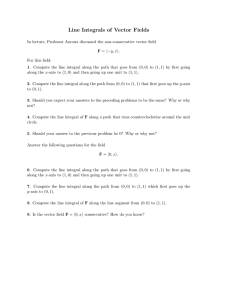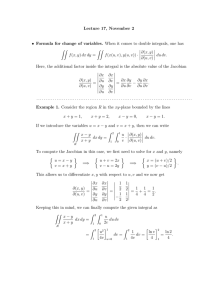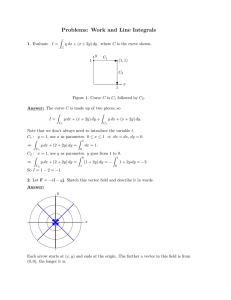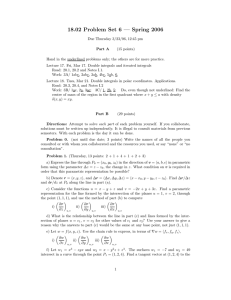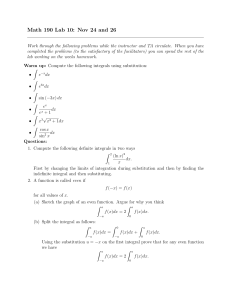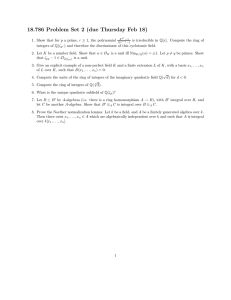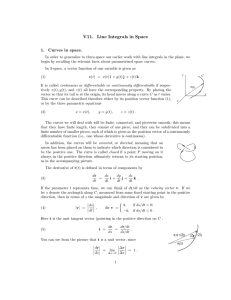Line Integrals of Vector Fields
advertisement
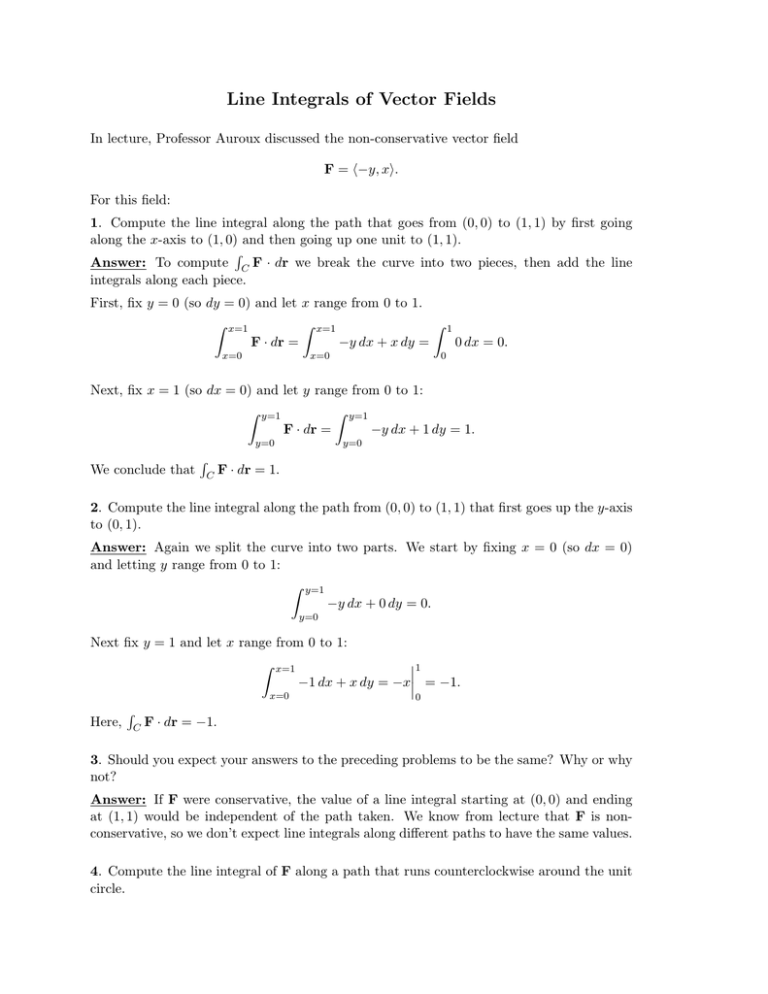
Line Integrals of Vector Fields In lecture, Professor Auroux discussed the non-conservative vector field F = (−y, x). For this field: 1. Compute the line integral along the path that goes from (0, 0) to (1, 1) by first going along the x-axis to (1, 0) and then going up one unit to (1, 1). Answer: To compute C F · dr we break the curve into two pieces, then add the line integrals along each piece. First, fix y = 0 (so dy = 0) and let x range from 0 to 1. x=1 x=1 F · dr = x=0 1 −y dx + x dy = x=0 0 dx = 0. 0 Next, fix x = 1 (so dx = 0) and let y range from 0 to 1: y=1 y=1 F · dr = y=0 We conclude that C −y dx + 1 dy = 1. y=0 F · dr = 1. 2. Compute the line integral along the path from (0, 0) to (1, 1) that first goes up the y-axis to (0, 1). Answer: Again we split the curve into two parts. We start by fixing x = 0 (so dx = 0) and letting y range from 0 to 1: y=1 −y dx + 0 dy = 0. y=0 Next fix y = 1 and let x range from 0 to 1: x=1 x=0 Here, C 1 −1 dx + x dy = −x = −1. 0 F · dr = −1. 3. Should you expect your answers to the preceding problems to be the same? Why or why not? Answer: If F were conservative, the value of a line integral starting at (0, 0) and ending at (1, 1) would be independent of the path taken. We know from lecture that F is nonconservative, so we don’t expect line integrals along different paths to have the same values. 4. Compute the line integral of F along a path that runs counterclockwise around the unit circle. Answer: We parametrize C by x = cos θ, y = sin θ with 0 ≤ θ < 2π. Then dx = − sin θ dθ, dy = cos θ dθ, and: Z Z θ=2π F · dr = C 2π Z (sin2 θ + cos2 θ) dθ = 2π. − sin θ dx + cos θ dy = θ=0 0 5. Should your answer to the previous problem be 0? Why or why not? Answer: The vector field is not conservative, so its line integral around a closed curve need not be zero. Answer the following questions for the field F = (0, x). 6. Compute the line integral along the path that goes from (0, 0) to (1, 1) by first going along the x-axis to (1, 0) and then going up one unit to (1, 1). Answer: We split the curve into two pieces as in problem (1). Z Z x=1 F · dr = C Z y=1 0 dx + x dy + 0 dx + 1 dy x=0 = 1. y=0 7. Compute the line integral along the path from (0, 0) to (1, 1) which first goes up the y-axis to (0, 1). Answer: Proceed as in problem (2): Z Z y=1 F · dr = C Z x=1 0 dx + 0 dy + y=0 0 dx + x dy = 0. x=0 8. Compute the line integral of F along the line segment from (0, 0) to (1, 1). Answer: Parametrize C by x = y = t where 0 ≤ t ≤ 1. Then Z Z t=1 t2 1 F · dr = 0 dt + t dt = = 1/2. 2 0 C t=0 9. Is the vector field F = (0, x) conservative? How do you know? Answer: The field F is not conservative. If it were, the line integrals in problems 6, 7 and 8 would depend only on the endpoints of C and so would have the same values. MIT OpenCourseWare http://ocw.mit.edu 18.02SC Multivariable Calculus Fall 2010 For information about citing these materials or our Terms of Use, visit: http://ocw.mit.edu/terms.
